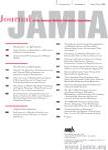版权所有:内蒙古大学图书馆 技术提供:维普资讯• 智图
内蒙古自治区呼和浩特市赛罕区大学西街235号 邮编: 010021

作者机构:Indiana Univ Sch Med Childrens Hlth Serv Res Indianapolis IN 46202 USA Indiana Univ Sch Med Regenstrief Inst Hlth Care Indianapolis IN 46202 USA
出 版 物:《JOURNAL OF THE AMERICAN MEDICAL INFORMATICS ASSOCIATION》 (美国医学信息学会志)
年 卷 期:2011年第18卷第4期
页 面:485-490页
核心收录:
学科分类:1205[管理学-图书情报与档案管理] 1204[管理学-公共管理] 1001[医学-基础医学(可授医学、理学学位)] 0812[工学-计算机科学与技术(可授工学、理学学位)] 10[医学]
主 题:Tuberculosis iron-deficiency anemia CHICA screening computer decision-support system visualization of data and knowledge knowledge representations communications networking methods mobility uncertain reasoning and decision theory languages computational methods advanced algorithms methods for integration of information from disparate sources distributed systems agents software engineering: architecture data models automated learning developing/using clinical decision support (other than diagnostic) and guideline systems discovery text and data mining methods
摘 要:Objective The Child Health Improvement through Computer Automation (CHICA) system is a decision-support and electronic-medical-record system for pediatric health maintenance and disease management. The purpose of this study was to explore CHICA s ability to screen patients for disorders that have validated screening criteria specifically tuberculosis (TB) and iron-deficiency anemia. Design Children between 0 and 11 years were randomized by the CHICA system. In the intervention group, parents were asked about TB and iron-deficiency risk, and physicians received a tailored prompt. In the control group, no screens were performed, and the physician received a generic prompt about these disorders. Results 1123 participants were randomized to the control group and 1116 participants to the intervention group. Significantly more people reported positive risk factors for iron-deficiency anemia in the intervention group (17.5% vs 3.1%, OR 6.6, 95% CI 4.5 to 9.5). In general, far fewer parents reported risk factors for TB than for iron-deficiency anemia. Again, there were significantly higher detection rates of positive risk factors in the intervention group (1.8% vs 0.8%, OR 2.3, 95% CI 1.0 to 5.0). Limitations It is possible that there may be more positive screens without improving outcomes. However, the guidelines are based on studies that have evaluated the questions the authors used as sensitive and specific, and there is no reason to believe that parents misunderstood them. Conclusions Many screening tests are risk-based, not universal, leaving physicians to determine who should have a further workup. This can be a time-consuming process. The authors demonstrated that the CHICA system performs well in assessing risk automatically for TB and iron-deficiency anemia.